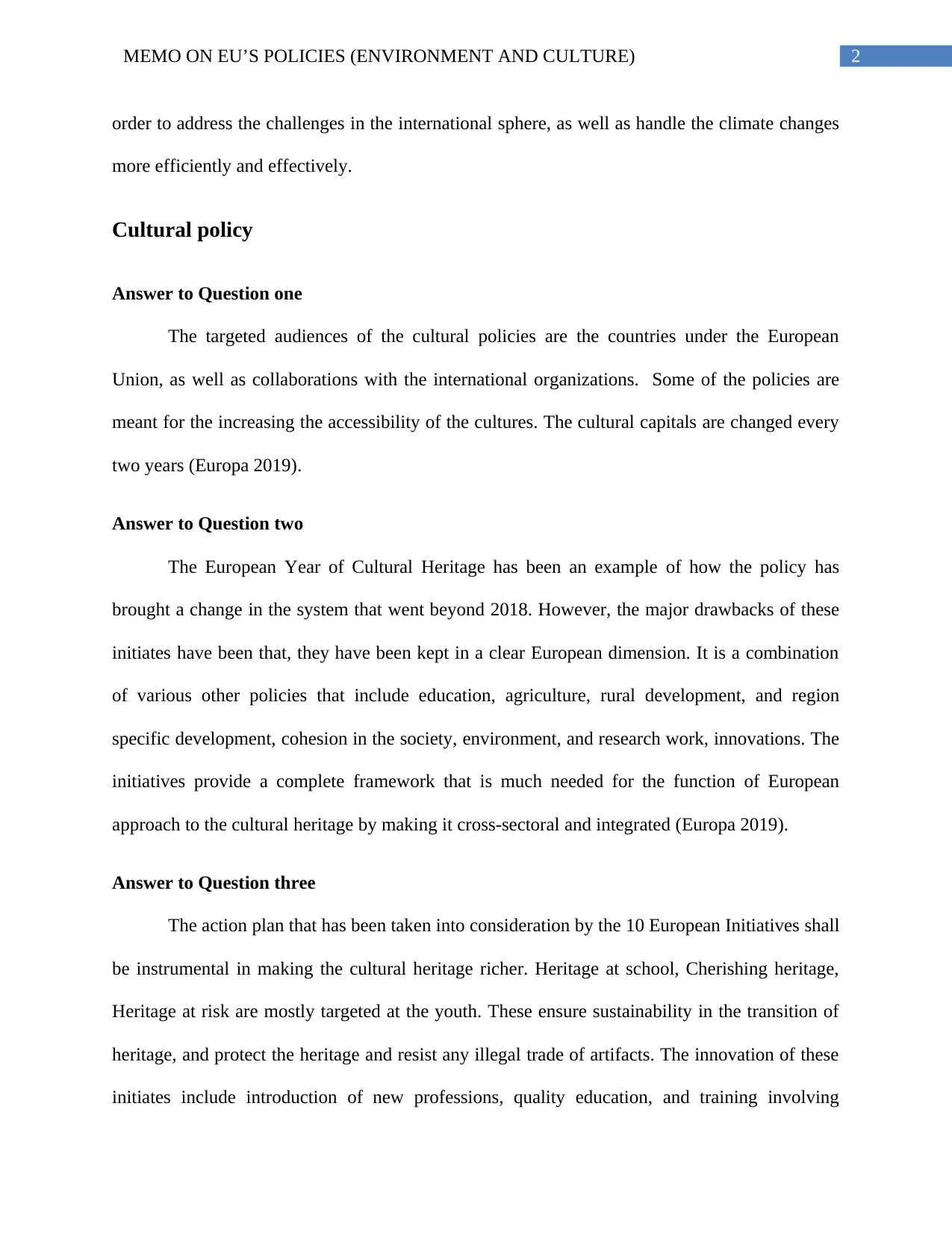Detailed Analysis: EU's Environment and Culture Policies Report
VerifiedAdded on 2022/10/10
|5
|772
|16
Report
AI Summary
This memo provides an analysis of the European Union's policies concerning the environment and culture. The environmental policy section discusses the EU's economic cooperation, objectives for environmental protection, resource efficiency, and low-carbon emissions, and the enablers for policy i...

Running Head: MEMO ON EU’S POLICIES (ENVIRONMENT AND CULTURE)
Memo on EU’s policies (Environment and Culture)
Name of the Student:
Name of the University:
Author Note:
Memo on EU’s policies (Environment and Culture)
Name of the Student:
Name of the University:
Author Note:
Paraphrase This Document
Need a fresh take? Get an instant paraphrase of this document with our AI Paraphraser

1MEMO ON EU’S POLICIES (ENVIRONMENT AND CULTURE)
Environmental policy
Answer to Question one
The economic cooperation between the European Countries began in the year 1951which
consisted of Belgium, France, Germany, Italy, the Netherlands, Luxembourg. Later the union
expanded to twenty-eight countries. It also includes the Schengen Area that is a border free area.
Albania, Montenegro, North Macedonia, Serbia, Turkey are I the process of being integrated in
the legislation; the potential candidates are Bosnia and Herzegovina. All of these countries are
the targeted audience (Knill & Liefferink, 2013).
Answer to Question two
Objectives of the EU are stretched beyond 2020 that targets a set a goal to be reached by
2050 that include: protection, conservation, and enhancement of the national capital that come
under the legislation of the EU (Wallace, Pollack & Young, 2015). Strive for efficiency in terms
of resources, low-carbon emission, and promotion of green economy. They also ensure the
citizens of EU from any pressure that is related to the environment, and poses a threat to the
health as well as the wellbeing.
Answer to Question three
Apart from the three objectives as mentioned previously, four enablers have been
included in order to ensure proper implementation of the legislation, gaining proper knowledge
and information, better plan for investment on climate policies, complete integration of
requirements regarding environment. Two additional goals are increasing the sustainability of the
cities under the union (Knill & Liefferink, 2013). It also plans to provide help to the union in
Environmental policy
Answer to Question one
The economic cooperation between the European Countries began in the year 1951which
consisted of Belgium, France, Germany, Italy, the Netherlands, Luxembourg. Later the union
expanded to twenty-eight countries. It also includes the Schengen Area that is a border free area.
Albania, Montenegro, North Macedonia, Serbia, Turkey are I the process of being integrated in
the legislation; the potential candidates are Bosnia and Herzegovina. All of these countries are
the targeted audience (Knill & Liefferink, 2013).
Answer to Question two
Objectives of the EU are stretched beyond 2020 that targets a set a goal to be reached by
2050 that include: protection, conservation, and enhancement of the national capital that come
under the legislation of the EU (Wallace, Pollack & Young, 2015). Strive for efficiency in terms
of resources, low-carbon emission, and promotion of green economy. They also ensure the
citizens of EU from any pressure that is related to the environment, and poses a threat to the
health as well as the wellbeing.
Answer to Question three
Apart from the three objectives as mentioned previously, four enablers have been
included in order to ensure proper implementation of the legislation, gaining proper knowledge
and information, better plan for investment on climate policies, complete integration of
requirements regarding environment. Two additional goals are increasing the sustainability of the
cities under the union (Knill & Liefferink, 2013). It also plans to provide help to the union in

2MEMO ON EU’S POLICIES (ENVIRONMENT AND CULTURE)
order to address the challenges in the international sphere, as well as handle the climate changes
more efficiently and effectively.
Cultural policy
Answer to Question one
The targeted audiences of the cultural policies are the countries under the European
Union, as well as collaborations with the international organizations. Some of the policies are
meant for the increasing the accessibility of the cultures. The cultural capitals are changed every
two years (Europa 2019).
Answer to Question two
The European Year of Cultural Heritage has been an example of how the policy has
brought a change in the system that went beyond 2018. However, the major drawbacks of these
initiates have been that, they have been kept in a clear European dimension. It is a combination
of various other policies that include education, agriculture, rural development, and region
specific development, cohesion in the society, environment, and research work, innovations. The
initiatives provide a complete framework that is much needed for the function of European
approach to the cultural heritage by making it cross-sectoral and integrated (Europa 2019).
Answer to Question three
The action plan that has been taken into consideration by the 10 European Initiatives shall
be instrumental in making the cultural heritage richer. Heritage at school, Cherishing heritage,
Heritage at risk are mostly targeted at the youth. These ensure sustainability in the transition of
heritage, and protect the heritage and resist any illegal trade of artifacts. The innovation of these
initiates include introduction of new professions, quality education, and training involving
order to address the challenges in the international sphere, as well as handle the climate changes
more efficiently and effectively.
Cultural policy
Answer to Question one
The targeted audiences of the cultural policies are the countries under the European
Union, as well as collaborations with the international organizations. Some of the policies are
meant for the increasing the accessibility of the cultures. The cultural capitals are changed every
two years (Europa 2019).
Answer to Question two
The European Year of Cultural Heritage has been an example of how the policy has
brought a change in the system that went beyond 2018. However, the major drawbacks of these
initiates have been that, they have been kept in a clear European dimension. It is a combination
of various other policies that include education, agriculture, rural development, and region
specific development, cohesion in the society, environment, and research work, innovations. The
initiatives provide a complete framework that is much needed for the function of European
approach to the cultural heritage by making it cross-sectoral and integrated (Europa 2019).
Answer to Question three
The action plan that has been taken into consideration by the 10 European Initiatives shall
be instrumental in making the cultural heritage richer. Heritage at school, Cherishing heritage,
Heritage at risk are mostly targeted at the youth. These ensure sustainability in the transition of
heritage, and protect the heritage and resist any illegal trade of artifacts. The innovation of these
initiates include introduction of new professions, quality education, and training involving
⊘ This is a preview!⊘
Do you want full access?
Subscribe today to unlock all pages.

Trusted by 1+ million students worldwide

3MEMO ON EU’S POLICIES (ENVIRONMENT AND CULTURE)
traditional professions. It also encourages participation of all communities. Involvement of
science opens scopes for the use of technology for beneficial use of preservation of heritage.
traditional professions. It also encourages participation of all communities. Involvement of
science opens scopes for the use of technology for beneficial use of preservation of heritage.
Paraphrase This Document
Need a fresh take? Get an instant paraphrase of this document with our AI Paraphraser

4MEMO ON EU’S POLICIES (ENVIRONMENT AND CULTURE)
Reference
europa (2019). 10 European Initiatives - Culture - European Commission. Retrieved 20
November 2019, from https://ec.europa.eu/culture/content/overview_en
europa(2019). Countries | European Union. Retrieved 20 November 2019, from
https://europa.eu/european-union/about-eu/countries_en
Knill, C., & Liefferink, D. (2013). Environmental politics in the European Union: policy-
making, implementation and patterns of multi-level governance.
Wallace, H., Pollack, M. A., & Young, A. R. (Eds.). (2015). Policy-making in the European
Union. Oxford University Press, USA.
Reference
europa (2019). 10 European Initiatives - Culture - European Commission. Retrieved 20
November 2019, from https://ec.europa.eu/culture/content/overview_en
europa(2019). Countries | European Union. Retrieved 20 November 2019, from
https://europa.eu/european-union/about-eu/countries_en
Knill, C., & Liefferink, D. (2013). Environmental politics in the European Union: policy-
making, implementation and patterns of multi-level governance.
Wallace, H., Pollack, M. A., & Young, A. R. (Eds.). (2015). Policy-making in the European
Union. Oxford University Press, USA.
1 out of 5
Related Documents
Your All-in-One AI-Powered Toolkit for Academic Success.
+13062052269
info@desklib.com
Available 24*7 on WhatsApp / Email
![[object Object]](/_next/static/media/star-bottom.7253800d.svg)
Unlock your academic potential
© 2024 | Zucol Services PVT LTD | All rights reserved.




